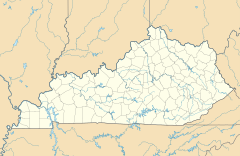Milton-Madison Bridge
| Milton–Madison Bridge | |
|---|---|
| Coordinates | 38°43′45″N 85°22′12″W / 38.729128°N 85.370114°WCoordinates: 38°43′45″N 85°22′12″W / 38.729128°N 85.370114°W |
| Carries | 2 lanes of |
| Crosses | Ohio River |
| Locale | Milton, Kentucky and Madison, Indiana |
| Other name(s) | Madison–Milton Bridge |
| Characteristics | |
| Total length | 3,184 feet (970 m) |
| Width | 20 feet (6.1 m) (original bridge) 40 feet (12 m) plus 5 feet (1.5 m) sidewalk (current bridge) |
| Longest span | 220 m |
| History | |
| Opened | 1929 (original bridge) 2014 (current bridge) |
| Statistics | |
| Daily traffic | 3,498/day |
| Toll | none |
The Milton–Madison Bridge (also known as the Harrison Street Bridge) is a continuous truss bridge that connects Milton, Kentucky and Madison, Indiana. It carries approximately 10,000 cars a day. The old structure was replaced with a completely new continuous truss which was constructed on temporary piers adjacent to the operational span between 2011 and 2012 and slid into place after demolition of the old span using a construction method called "truss sliding." The new crossing opened to vehicle traffic in April 2014, and a pedestrian sidewalk opened that October.
This two lane vehicular bridge is the Ohio River crossing for U.S. Route 421. The bridge has a main span of 600 feet (180 m) and total length of 3,184.2 feet (970.5 m). The original bridge had a deck width of a mere 20 feet (6.1 m), and above the deck the vertical clearance was 16.8 feet (5.1 m). The new bridge has a 40-foot (12 m)-wide road bed, plus a 5-foot (1.5 m) cantilevered pedestrian-only path. Bicyclists are banned from the sidewalk, but may use the new bridge's 8-foot (2.4 m) shoulders. This bridge is the only vehicular crossing of the Ohio River for 26 miles (42 km) going upstream (the Markland Bridge near Vevay, Indiana) and 32 miles (51 km) downstream (the Lewis and Clark Bridge in northeast Louisville).
The bridge provides the shortest distance between Indianapolis, Indiana, and Lexington, Kentucky.
Built by J.G. White Engineering Corp., construction was started in 1928, and completed in 1929, at the cost of $1,365,101.84. It was opened for traffic on December 20, 1929. Originally a toll bridge, on November 1, 1947 at noon the toll was removed.
In 1997 the bridge was refurbished. This was after a 1995 study which could not agree on a new bridge location, so $10 million was used for the refurbishment.
The bridge was replaced in the first half of the 2010s, as the original bridge was "functionally obsolete" and "structurally deficient." It had a sufficiency rating of 33 out of a possible 100; its superstructure condition rating was considered "poor". Modern trucks were unable to safely use the old bridge. One of the boons of the new bridge would be to aid a $20 million "resort and entertainment center" where a cotton mill once stood.
...
Wikipedia

